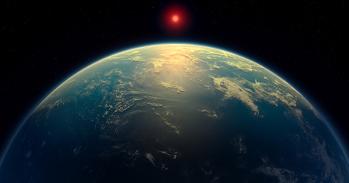
It is theoretically possible that habitable planets exist around pulsars - spinning neutron stars that emit short, quick pulses of radiation. According to new research, such planets must have an enormous atmosphere that converts the deadly x-rays and high energy particles of the pulsar into heat. The results, from astronomers at the University of Cambridge and Leiden University, are reported in the journal Astronomy & Astrophysics.
It is theoretically possible that habitable planets exist around pulsars - spinning neutron stars that emit short, quick pulses of radiation. According to new research, such planets must have an enormous atmosphere that converts the deadly x-rays and high energy particles of the pulsar into heat. The results, from astronomers at the University of Cambridge and Leiden University, are reported in the journal Astronomy & Astrophysics.
Pulsars are known for their extreme conditions. Each is a fast-spinning neutron star - the collapsed core of a massive star that has gone supernova at the end of its life. Only 10 to 30 kilometres across, a pulsar possesses enormous magnetic fields, accretes matter, and regularly gives out large bursts of X-rays and highly energetic particles.
Surprisingly, despite this hostile environment, neutron stars are known to host exoplanets. The first exoplanets ever discovered were around the pulsar PSR B1257+12 - but whether these planets were originally in orbit around the precursor massive star and survived the supernova explosion, or formed in the system later remains an open question. Such planets would receive little visible light but would be continually blasted by the energetic radiation and stellar wind from the host. Could such planets ever host life?
For the first time, astronomers have tried to calculate the ‘habitable’ zones near neutron stars - the range of orbits around a star where a planetary surface could possibly support water in a liquid form. Their calculations show that the habitable zone around a neutron star can be as large as the distance from our Earth to our Sun. An important premise is that the planet must be a super-Earth, with a mass between one and ten times our Earth. A smaller planet will lose its atmosphere within a few thousand years under the onslaught of the pulsar winds. To survive this barrage, a planet’s atmosphere must be a million times thicker than ours - the conditions on a pulsar planet surface might resemble those of the deep ocean floor on Earth.
The astronomers studied the pulsar PSR B1257+12 about 2300 light-years away as a test case, using the X-ray Chandra space telescope. Of the three planets in orbit around the pulsar, two are super-Earths with a mass of four to five times our Earth, and orbit close enough to the pulsar to warm up. According to co-author Alessandro Patruno from Leiden University, “The temperature of the planets might be suitable for the presence of liquid water on their surface. Though, we don't know yet if the two super-Earths have the right, extremely dense atmosphere.”
In the future, Patruno and his co-author Mihkel Kama from Cambridge's Institute of Astronomy would like to observe the pulsar in more detail and compare it with other pulsars. The European Southern Observatory’s ALMA Telescope would be able to show dust discs around neutron stars, which are good predictors of planets. The Milky Way contains about one billion neutron stars, of which about 200,000 are pulsars. So far, 3000 pulsars have been studied and only five pulsar planets have been found.
Reference:
A. Patruno & M. Kama. ‘Neutron Star Planets: Atmospheric processes and habitability.’ Accepted for publication in Astronomy & Astrophysics.
Adapted from a NOVA press release.

The text in this work is licensed under a Creative Commons Attribution 4.0 International License. For image use please see separate credits above.




